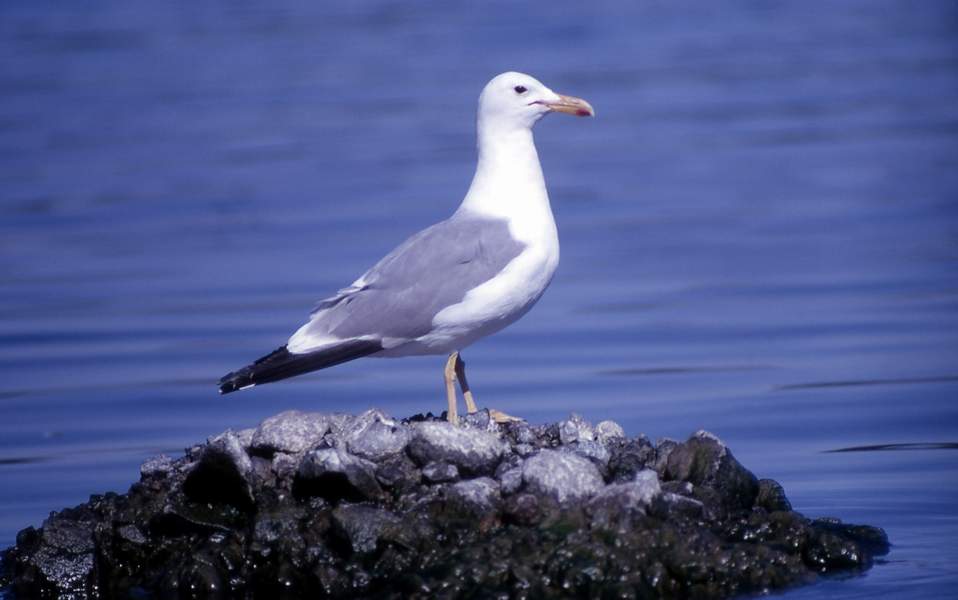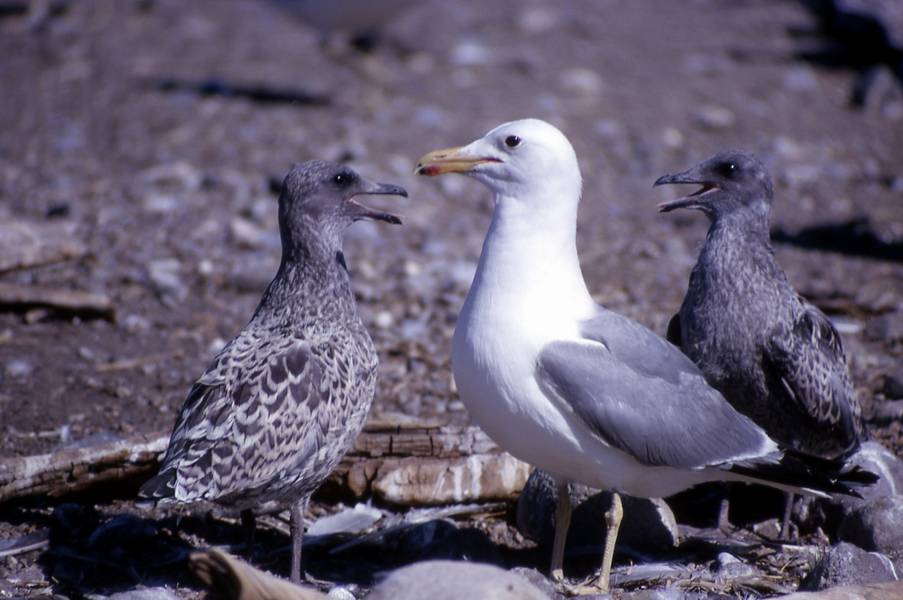California Seagull (Larus californicus)
The California Seagulls are a common bird in western North America. They look like the smaller Ring-billed Gull; both have yellowish green legs.
They have a red and black spot on the lower bill while the Ring-billed Gulls have a complete black ring near the tip of the bill;
one has dark eyes and the other yellow eyes.
In the summer the California gulls range from Great Slave Lake, Canada, south to Mono Lake, California, and from Klamath Lake, Oregon, east to Stump Lake, North Dakota.
In the winter they migrate in a westerly direction along the coast from British Columbia south to Colima, Mexico.
Their habitats include seacoasts, lakes, farms, and urban centres.
They nest on or near the shores of low-lying island in marshes and freshwater or saline lakes.
Their nests are rather large, generally fourteen to eighteen inches in diameter, and made of dried weeds, sticks, grass, feathers, and pieces of man-made materials.
One nest typically holds two or three eggs of variable shades of brown or grey colour with small, irregular dark spots.
The juvenile gulls start with a very dark brown plumage, a black bill and dark yellow green legs.
In the first winter, the dark colour becomes lighter and mottled.
In the second winter, the wings show a light grey colour, a light lower body,
a whitish head mottled brown, and a dark tail. In the third winter, the colours change to be more solid,
but still some mottled brown spots. The gulls will then attain its mature plumage of white body and dark grey wings at the fourth winter.
One thing unusual about this common bird is that it was selected as the Utah State Bird by common consent,
and probably to commemorate a miraculous event in 1848.
In 1847, the Mormons had continued fighting with other settlers in Illinois.
A group of 2,000 Mormons moved to Salt Lake Valley. The pioneers first noticed the abundance of black "crickets"
which were used as food by Native Indians in the area. When 2,400 more Mormons joined the first group in 1848,
hordes of crickets suddenly descended and destroyed their crops.
According to the writing of a doctor Priddy Meeks: "Finly, the crickets came so thick it made the earth black in places,
and it did look like they would take what little we had growing, which looked nice and flourishing ...
Now everything did look gloomy. Our provishions giveing out, and the
crickets eating up what little we had growing, and we a thousand miles away from supplies.
Utah State Bird & Flower, 1982 postal stamp
... When Sunday come, we had a meeting. Apostle Rich stood in a open wagon and preached out of doors ... While preaching, he says, 'Brotherin, we do not want you to part with your wagons and teams, for we might need them.' Intimating that he did not know, but we might have to leave. That increased my solemnity. At that instant, I heard the voice of fowles flying overhead, that I was not acquainted with, I looked up and saw a flock of seven gulls. In a few minits there was another larger flock passed over. They came fast and more of them untill the heavens were darkened with them, and lit down in the valley till the earth was black with them, and they would eat crickets and throw them up again and fill themselves again and right away throw them up again. A little before sundown, they left for Salt Lake, for they roosted on a sand bar. A little after sunrise in the morning, they came back again and continued that course until they had devoured the crickets .... "
['The Miracle of the Gulls' by John L. Hart,1998].
That year, the crickets did not become a devastation for the Mormon pioneers. In subsequent years, the gulls came again and destroyed the insects.
Years after this event, ornithologists analyzed this event and concluded that the behaviour of the gulls was not unusual because
large flocks of the gull often spent spring and summer at the Great Salt Lake and their diets included crickets,
grasshoppers, and other insects. Sceptics considered this 1848 event of the quick multiplication of crickets and
the sudden appearance of gulls, and even the subsequent eradication of cricket for that time was a simple coincidence in the nature.
However, with or without considering this event an intervention by divinity, it had truly lifted the spirits of the pioneers
and really had saved them from a disaster. In 1913, the still grateful Mormons erected a monument in Salt Lake City to honour the gulls.
In 1955, the California Seagull was selected as the Utah State Bird by an act of the legislature in 1955.
Data
Wing Span: 20-23" (50-58 cm)Habitat: Seacoasts, lakes, farms, urban centre
Nest: 2-3 eggs
Incubation period: 23-27 days
Unfledged to fully-fledged: 45 days after hatching
Longevity Record: 24 Years and 11 months (according to USGS Bird Banding Lab)

California Gull, Yellowstone Lake

Adult and Two Juveniles
Source: www.weforanimals.com Images by Bryan Harry, NPS Photo